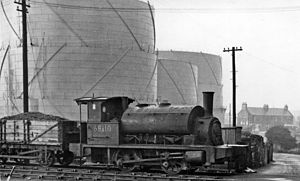- NBR G Class
-
NBR G Class
LNER Class Y9
Class Y9 68110 at Kipps Shed in 1961. Note the tender, used for carrying extra coal and the dumb buffers to prevent buffers interlocking while shunting. Power type Steam Designer Neilson and Company Builder Neilson and Company Build date 1882-1899 Configuration 0-4-0ST Gauge 1,435 mm (4 ft 8 1⁄2 in) Driver diameter 3 ft 8 in (1.12 m) Locomotive weight 27.8 long tons (28.2 t) Tender weight 6 long tons (6.1 t) Fuel type coal Boiler pressure 130 psi (0.90 MPa) Cylinders two outside Cylinder size 14 × 20 in (360 × 510 mm) Tractive effort 9,845 lbf (43.79 kN) Class 0F The North British Railway (NBR) G Class (LNER Class Y9) is a class of 0-4-0ST steam locomotive designed for shunting. Some locomotives were equipped with small wooden tenders to carry extra coal. They were introduced in 1882 and thirty-eight entered service on the NBR between 1882 and 1899. Like most 0-4-0 tanks of the period it has outside cylinders and inside slide valves driven by Stephenson valve gear.
Contents
Origin
Industrial locomotives
The design was originated by Neilson and Company of Hyde Park Works, Springburn, Glasgow, who built the first examples of the type, mainly for industrial customers, in the 1870s. One such, built in 1876, is in the collection of the Scottish Railway Preservation Society at Bo'ness.[1]
Caledonian Railway
Main article: Caledonian Railway 0F classAlso in 1876, the Caledonian Railway bought from Neilsons four locomotives of the same design.[2] Between 1885 and 1908, the Caledonian built thirty-four more, at the company's own works at Glasgow St Rollox.
North British Railway
The "G" class on the North British Railway came about in much the same way – the NBR bought two locomotives from Neilson in 1882, and by 1899 they had built thirty-six for themselves at their Cowlairs Works.[3] Effectively, Neilsons seem to have licensed the design to the two main line railways, both of whom built it with detail modifications and then ascribed the design to their Chief Mechanical Engineers, Dugald Drummond and Matthew Holmes.
Great Eastern Railway
The Great Eastern Railway Class 209 is similar but has a flat-topped saddle tank. One example is preserved at North Woolwich Old Station Museum.
LNER and BR ownership
The LNER acquired most of the NBR examples in 1923 and classified them Y9. Thirty-three of them passed into British Railways ownership in 1948 and were numbered 68092–68124.
Preservation
One, NBR No.42 (BR 68095), has survived to preservation in the Scottish Railway Preservation Society collection and is a static exhibit. This was bought from British Railways straight out of traffic at St Margaret's Shed, Edinburgh by J.Morris, and was displayed at his former museum at Lytham St Annes until it was bought by SRPS in 1992.
An example of the original design by Neilson & Co. is also preserved by the Scottish Railway Preservation Society. It was built in 1876 and named Kelton Fell.[4]
References
- ^ 0-4-0ST William Baird & Co. "Kelton Fell"
- ^ Mackintosh, Jim (January 2007). ""Pugs", Horses and Men". The True Line (The Caledonian Railway Association) (No.95): 7,8. ISSN 02670852.
- ^ Fry (ed.), E.V. (1977). Locomotives of the LNER: Part 9B, Tank Engines classes Q1 to Z5. Railway Correspondence & Travel Society. p. 102.
- ^ Kelton Fell
Sources
- Ian Allan ABC of British Railways Locomotives, 1948 edition, part 4, page 46
External links
London and North Eastern Railway locomotives Pre-grouping railway designs: D38 • D39 • D40 • D41 • D42 • D43 • D44 • D45 • D46 • D47 • D48 • G10 • J90 • J91 • Z4 • Z5A2 • A6 • A7 • B13 • B14 • B15 • B16 • C6 • C7 • C8 • D17/1 • D17/2 • D18 • D19 • D20 • D21 • D22 • D23 • E5 • E6 • F8 • G5 • G6 • H1 • J21 • J22 • J24 • J25 • J26 • J27 • J71 • J72 • J73 • J74 • J76 • J77 • J78 • J79 • N8 • N9 • N10 • Q5 • Q6 • Q7 • T1 • X1 • X2 • X3 • Y7 • Y8 • EB1 • EE1 • EF1 • ES1D24 • J23 • J28 • J75 • J80 • N11 • N12 • N13 • Q10LNER designs: Gresley (1923–1941):Thompson (1941–1946):Peppercorn (1946–1947):Other designs: Categories:- North British Railway locomotives
- 0-4-0ST locomotives
- Railway locomotives introduced in 1882
- Neilson locomotives
Wikimedia Foundation. 2010.
